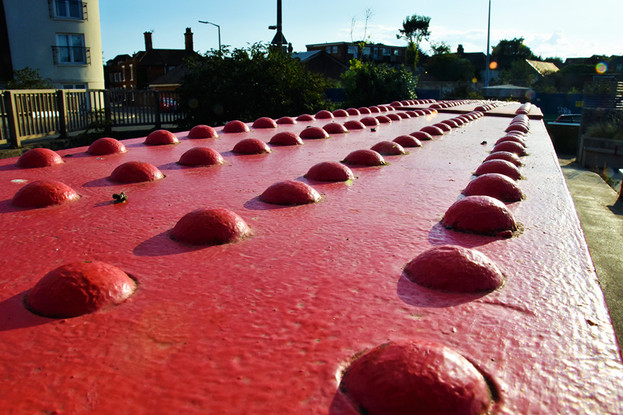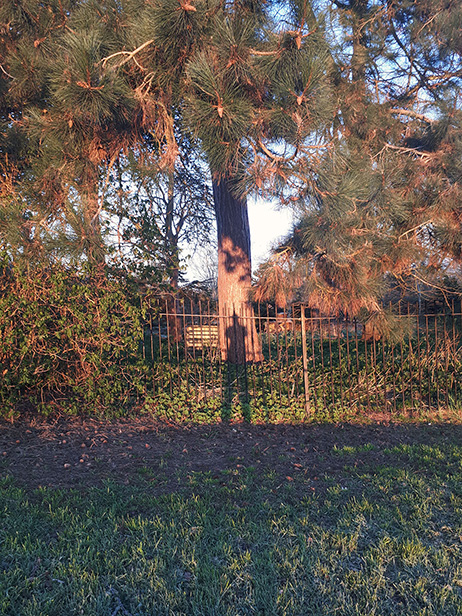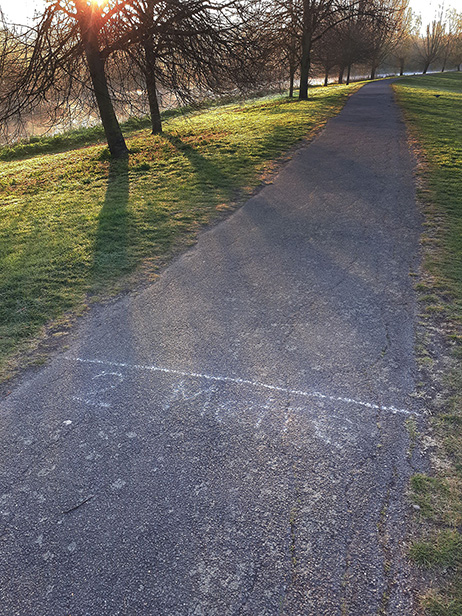A photographic voice
- Walk Colchester

- May 6, 2020
- 11 min read
Updated: Mar 31, 2022
By Jonathan Doyle
Images by Sunday Traders photographers
One of the most interesting consequences of Sunday Traders’ photographers sharing their work together has been their diverse exploration of the same subject matter. Despite individual group members often going out for their photo walks together and seeing the same things, they were clearly looking in their own ways. Here, Jonathan Doyle takes a closer look at a few of the images and hears from the photographers behind the pictures about what inspired their work.
(Images: Doug Wyatt)
Doug Wyatt has been shooting since the mid-80s, using anything from 110 to 35mm and medium format film cameras. He loves the quality of aging prime (fixed focal length) lenses, he says and still buys vintage glass from time to time, although now mainly using them on his digital cameras. ‘You can pick them up very cheaply and they’re often in good order’, he tells me. But, for many of his Sunday Traders’ shots, he used an iPhone 4. ‘I like the freedom it gives you’, he says, ‘and you can be very discreet when taking street pictures’.
For the pictures above, Doug turned his attention to posters and the people who come into the frame near them. ‘I’ve always looked at posters and things in shop windows. Sometimes, people are unaware they’re near a poster’, he explains. He’s selective and patient, though: ‘It’s got to be the right sort of the person. The person has got to have that sort of character.’ He likes the humour the positioning often brings. But sometimes there is more, the longer we look. We don’t know the characters involved, or anything of their circumstances, so we extrapolate and build stories for ourselves.

(Image: Doug Wyatt)
Sometimes, Doug’s interest is not always dependent on finding a human interaction at all. In some shots, he is simply finding a picture in something inanimate. In this image, he’s still concentrated on shops, but this time with not a person in sight. ‘You’ve got to keep your eyes open’, he says. ‘There’re opportunities out there. Sometimes I try and stick to a theme.’ Just like his poster shots, we know an inanimate object cannot really be interacting with its surroundings. And yet, as we look at what Doug has noticed, the impossible becomes slightly less implausible.

(Image: Doug Wyatt)
Another picture from Doug Wyatt absolutely must get a mention. His shot above of a family was one of the group’s favourites and of course it’s easy to understand why. He’d seen them approaching and knew that there would be one shot that would make a picture, so he positioned himself to ensure a good background and waited. He used the ‘burst’ mode on his camera to give himself a few options as they walked past and, sure enough, there was one frame in the run which gave him the result he wanted.

The ambiguity of the apparent life of the inanimate object is also beautifully illustrated in Chrissie Alexander’s quite simple but very funny picture of a street crossing (left). In keeping with all the Sunday Trader shots, everything is found and nothing is staged. In that sense, this is street being reportage. Someone else had left the beer bottle on the crossing, Chrissie simply spotted it and captured the crossing man’s apparent indignation. She likes, she says, capturing ‘anything quirky and humorous’ and a picture like this worked well for her in the early days of the group. ‘I sometimes felt nervous about asking people for permission to take their photo’, she admits. ‘I’ve been doing street photography for a while but it still depends on how you’re feeling some days’. It got easier for her as the project went on, she says. ‘I learned to be bolder and to engage with the public. People very rarely said no’.

(Image: Chrissie Alexander)
In Chrissie’s next shot, her picture’s sheer energy brings real sense of dynamic action and sets the skateboarders against the familiar backdrop of Firstsite’s entrance. The picture stands on its own merit as an arresting picture but, around here at least, it could quite easily also open a wider debate, well beyond its obvious aesthetics. To my mind, that adds value to it as a picture.
The skateboarders very presence denotes perhaps an unforeseen consequence of the original design for the area. The interest of one tranche of the population in what was being built was not properly anticipated. The initial construction of the walls, seats and steps outside Firstsite turned out not to be quite skateboarder proof and later had to be protectively modified. It reminds us perhaps that, ultimately, public spaces will be used by the public largely as they wish. They should not be designed purely for a utopian vision which strays too far from urban reality. They have instead to be designed for everyone and the reality we collectively bring with us. Certainly, there is no denying the skill of the skateboarders and the effort they put into practicing. And, few would question that they’ve enjoyed using the plaza all these years. However, I sometimes wonder if there is still an underlying tension in some quarters over their continued presence. Chrissie’s picture depicts their enjoyment strongly but it nevertheless associates a locally famous space with those whom some may regard as a nuisance. To my mind, that adds a dimension of tension to the picture, which I think adds to its value as a reportage image.

(Image: Chrissie Alexander)
In another Chrissie picture, a scattering of ornaments and other household items is photographed, untouched and unarranged, exactly as they were found on the ground in front of a skip outside a charity shop. We know absolutely nothing of their provenance apart from what we may guess at. This photograph can clearly feed our imaginations. It’s stronger for sentiment than it is for fact. As a photograph, which never lies, it nevertheless tells us almost nothing in this instance. And yet it brings us something still. As collection of a few odd pieces, which may never even have been owned by one individual person, its subject matter may be nothing more than some junk that even a charity shop cannot sell. Unconnected odd pieces which remained unwanted too long on the shelves of the shop? Or, maybe not. For all we know, they may be the last we’ll see of some stranger’s material life, their day-to-day trinkets, their souvenirs from holidays, their presents from their family and, near the centre of the frame, their small framed photograph of someone whom we could very easily assume once meant something special to them. Matthew, as a young boy. We just don’t know more than we can see in the picture and, as such, we don’t accurately know what it is we are seeing. It may be Matthew's business but it’s not ours. And yet, whatever the story really is, if indeed there is one, it lingers with us and we’d like to know more. Humans are inherently inquisitive and street photographers are often quite driven by the instinct.

(Image: Steve Ball)
While we’re looking at stories, the picture above by Steve Ball is a good one. The first is in the paper, although we can’t read much beyond the headline. The second, he says, is in what we don’t know. ‘To me there’s a tension, with the fact that someone’s actually been sitting there, with those cigarettes and reading that story but you can’t see them. They’ve left and that’s what they’ve left behind’. And the nature of the hard news content against the much softer backdrop of the teashop or café. What do we make of that? The photograph gives us things we wouldn’t necessarily associate together and lets us build up from there.

(Image: Rowena Macaulay)
A number of Sunday Traders’ pictures will build into a strong record of the ‘now’, ready for us when we contemplate the inevitable consequences of change. In our present predicament, we are much less certain of the future of our shopping streets than we were even a few months ago. In Rowena Macaulay’s shot, taken in Colchester’s Queen Street in 2017, the ‘now’ depicts an interesting quaintness and charm, a shop in which time appears to be standing still. Yet, embedded within it is an unforeseen foreboding, and something none of us were thinking about back then. Suddenly, the picture is also very modern, very now. It’s just a word of course, a brand from a forgotten era suddenly thrust into our present consciousness. As Rowena observed, ‘We don’t notice words until we have a reason . . . Then they come into our vocabulary and we spot them everywhere’.

(Image: Rowena Macaulay)
At the bottom of the same street, another Rowena picture shows us another shop space, this one bathed in the soft glow of a warm golden light. For Rowena though, ‘It feels bleak. It’s a space which has been and gone’, she says. A former wedding shop, it’s the end of someone’s dreams, as are so many empty stores. We know to expect more of them in the coming months. But, she adds, ‘I like the fact it’s kind of playful. You can’t see where that shadow comes from’.

(Image: Rowena Macaulay)
Next, also from Rowena, a very different kind of emptiness. This time what we are seeing is no slow decline into trade-less oblivion (we hope, at least) but rather the sudden shock of the unexpected. On Mothers’ Day this year, the shelves in Waitrose should have been packed full. Instead, we were left only with the few odd items the public had decided not to stockpile. It struck Rowena as curious that jars of olives and roasted peppers had been left. ‘I homed in on it. In a way, you have to because you have to eat what’s left in store. I thought that’s interesting because I love that food.’ Rowena had ventured out to shop for her father. ‘Even though I’d heard so much about empty shelves, it was still genuinely shocking to see it for myself, to realise that they were that empty.’ But, she says, ‘There was a sense of excitement in the store. Not a positive excitement. The anticipation of some event. At this point people weren’t really socially distancing that much. The thing about 2m hadn’t really quite grabbed hold of us’. As we become accustomed to our new normal and stock returns to grocery shelves, Rowena’s striking picture already hints more of ‘then’ than ‘now’. History can move fast sometimes.

(Image: Steve Ball)
It’s perhaps a little obvious to start looking for a sense of ‘now’ in pictures we know were taken ‘then’ but it’s surprisingly compulsive and gives some of the pictures an extra dimension. In the picture above, Steve Ball captures a strong sense of social distancing in a shot taken before any of this ‘now’ had even started. Steve likes the converging lines which guide us through the picture. He finds them for his pictures quite a lot, he says. ‘I’d clocked the wall. I milled around there. I just waited to see who’d come by. When I saw this guy, I knew I had to be really quick.’ He says he’ll show it at his local camera club, although he thinks the judges may be unmoved. ‘Anything street, they’ll say “Oh, that’s a fun shot”, and then they’ll dismiss it’.
(Images: Ron Bell)
Two other strong converging lines images from the group were both taken by Ron Bell. Most of us locally will know the riveted bridge across the River Colne at The Hythe but Ron’s picture of it gives us a real sense of its sheer mass and strength. An artefact of the area’s strong industrial past, Ron photographed the bridge in a contemporary, dynamic way. In his second picture, an empty shelf shot uses converging lines to give us a sense of the scale of what was happening in shops but this time concentrating on a different angle emerging from the coronavirus era – outbreaks of people doing interesting new things.
(Images: Kate Wilcox)
Finally, on converging lines, Kate Wilcox explored lockdown isolation and emptiness in her two shots shown above. The first, a self-portrait, puts her own fleeting shadow in her outside landscape during an exercise walk, while the second, with its subtle nod to the transition we must all make as we venture outside reminds us of our hope that this new order will be not be permanent. Kate says she was given her first camera when she was about nine. ‘I don’t remember taking my first photo’, she says, ‘but looking back at some of my old albums, I liked taking pictures looking at something from different viewpoints and perspectives’.
(Images: Kate Wilcox)
A real strength in Kate’s work, to my mind, is her ability to see the stillness around her. In the two pictures above, humans are not necessary although their presence is clearly felt in what they’ve built. Instead of people, we’re left to contemplate other things, such as colours and shapes, from the calming pastel tones in the first image to the almost eerie strong glow in the second. One building is still quite new while the other is now quite decayed. Both have a beauty. Kate’s exploration of their forms and tones in the light she found playing on them reminds us to look around us constantly and find the extraordinary in the ordinary.
(Images: Doug Wyatt)
Two images from Doug Wyatt further illustrate form beautifully. Both shop windows lend themselves to the high contrast black and white images he has captured and, rather like Kate’s two shots above, one has a gentle serenity while the other a sharper bite. Both are very purposeful. Both were shot on his iPhone 4. Sometimes when he is out shooting, Doug says he gives himself a time limit. ‘Once you’ve got your first couple of shots’, he says, ‘then you’re in’. ‘You start seeing better’.

(Image: Robin Richardson)
Another favourite subject among photographers on the street is graffiti. Whole books have been devoted to the art of it and it’s certainly worth photographing it when its seen, wherever you are. Often, it’s transitory and it gets cleaned off or overwritten by someone else’s work as they take their turn to reflect on the times in which we live. Here, Robin Richardson’s study of a derelict wall records a constant of time itself, that simple enough looking formula with which Einstein explained the basis of, well, pretty much everything.
(Images: Ben Heather)
Textures interested the group on their walks and the images above by Ben Heather shows what riches can be found. A photographer whose day job involves photographing gardens and plants, which are often used in very glossy magazines and on TV, Ben’s study in the first picture here is of the rich textures in an old building’s wall. His picture shows us some of its history, not only in the original wattle and daub but in the adaptation and repairs made over the years to this building, plus of course, the graffiti layered on top. Not a person in sight but clearly the work of several people on show. In the second shot, the corrosion of water makes an interesting pattern on a surface and the colours of decay blend perfectly. ‘Doing street photography makes you realise that there are images to be made everywhere and compels us to look for details that you would normally walk past’, he explains.

(Image: Matt Biggin)
Colours and texture are also perfectly illustrated in Matt Biggins’ picture of the decaying boat above. Before we were distracted with the coronavirus epidemic, our concerns increasingly contemplated what we are doing to nature. We’ll come back to it of course. It’s interesting sometimes however to look at it another other way, at least photographically speaking, and see what nature can do for itself. Nature, especially where water is concerned, will often win out over time. Despite several millennia of so-called progress, we humans have yet to counter the destructive effect of saltwater on the things we make.
Looking through Sunday Traders’ work again to write this article, I constantly found new things. Picking out just a few of the group’s pictures for a deeper look brought me new connections. That to me is the value of a good picture over time. The group’s documentation of the here and now was not their deliberate intent at the outset. It just happened to turn out that way. Sunday Traders was started as something to do for people interested in photography over a Jane’s Walk weekend and who wanted to get out and share the experience of seeing. But, frame by frame, their work is building into a record and feels like its value will endure. Of course, it would be pretentious and arrogant to think it was a record of all of it, or even most of it. It is neither. Always, there is so much more to see and as we know so acutely now, change comes towards us whether we are looking out for it or not.

(Image: Ron Bell)
© (images) photographers as credited 2017-2020; (text) Jonathan Doyle 2020. All rights reserved.






























Comments